Installing, configuring and testing Exchange 2007 CCR on Mailbox Server (Part 1)
Henrik Walther
Exchange Server 2007 introduces a number of new features, one of which is the Cluster Continuous Replication ( CCR) feature. This feature requires the new Exchange Server 2007 log file transfer and replay features, plus a combination of them with Windows 2003 built-in features (2 cluster nodes active / passive). This feature in Windows 2003 has many advantages, but it also has some disadvantages that still have an error point when referring to Exchange databases.
Prerequisites
To follow the steps throughout this series, you need to do the following:
- Windows 2003 Active Directory forest has at least one Domain Controller.
- Two versions of Windows 2003 Server R2 Enterprise or Windows 2003 Server SP1 Enterprise.
- A Windows file sharing Witness (Microsoft recommends that the Exchange 2007 Hub Transport Server in Exchange 2007 exists)
Note
Remember to apply the upgrade mentioned in the MS KB 921181 link to both servers that will work as nodes in the Exchange Server 2007 Clustered Mailbox installation. This upgrade adds a new file sharing validation feature to the current Majority Node Set (MNS) model. This file sharing validation feature allows you to use an external file share for the cluster as a traditional 'vote' for the purpose of indicating the status of the cluster in the deployment of the two-rule model. The MNS node, which is a procedure to use for continuous cluster copy functionality (abbreviated as CCR) in Exchange Server 2007.
In addition to the above prerequisites, you should have some knowledge about the general requirements below:
- When dealing with CCR environments, you must or may only use one database on one storage group.
- You cannot create a public folder database in a CCR environment if there are already many bibliographic databases in your organization.
- You can create up to 50 storage groups and 50 databases on a CCR cluster. Be aware that you should only create one database on each storage group.
- The cluster in Exchange 2007 installed cannot have Exchange Server 200x, or any version of Microsoft SQL Server. Not supported for running Exchange 2007 in a cluster with any other applications.
Warning
Since Exchange Server 2007 Beta does not support in a production environment, unless you participate in a fast deployment program (RDP) or a new technology testing program (TAP), you must install the cluster mailbox in the domain under test. to try on.
Configure network settings for Cluster nodes
When you launch servers to make nodes in a cluster, start by naming machines such as E2K7Node1 and E2K7Node2 or whatever name you want to use (these names don't need to be real). What to do with the Exchange server name that your clients will be configured to connect to later. Name the network connections Public and Private corresponding to the internal network and the external network (remember to do this for both nodes).
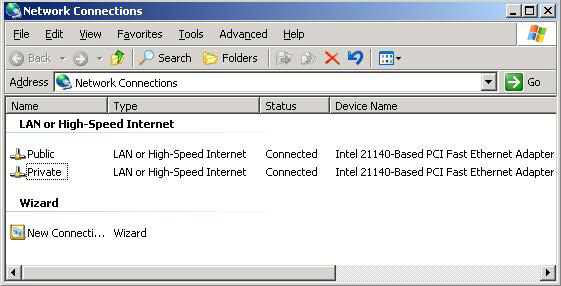
Figure 1: Network connections
Click Advanced > Advanced Settings , if that's not the case, make sure Public is listed first in the connection order list, then Private and finally Remote Access Connections .
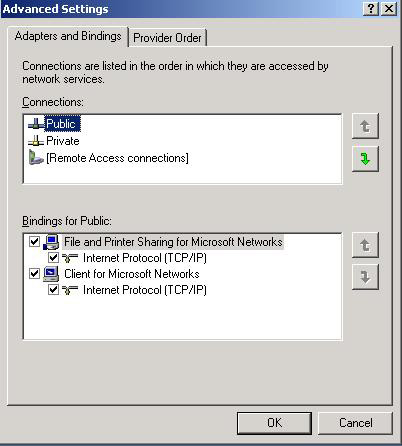
Figure 2: Connection order
You also need to make sure that File and Printer Sharing for Microsoft Networks is not marked for Private network connection.
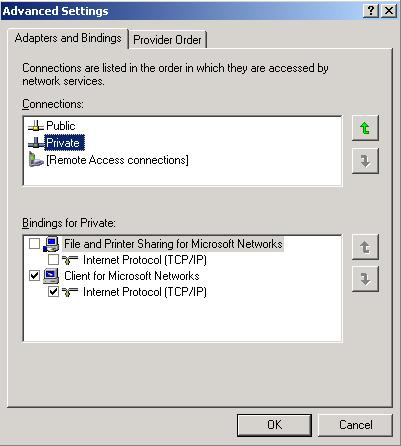
Figure 3: Disable File and Printer Sharing for Microsoft Networks
Configure Public network with the corresponding network settings you use in your test environment.
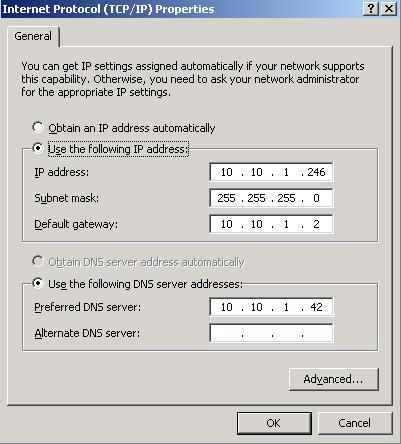
Figure 4: Configuring Public network
Private network configuration with IP address and a subnet mask. There is no longer any requirement because this network is only used for communication (heartbeat) between nodes in a cluster.
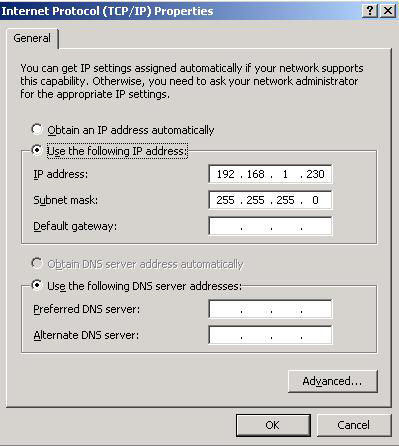
Figure 5: Configuring Private network
Now click Advanced and then select the DNS tab. Here, you should uncheck both Register this connection's addresses in DNS and Use this connection's DNS suffix .
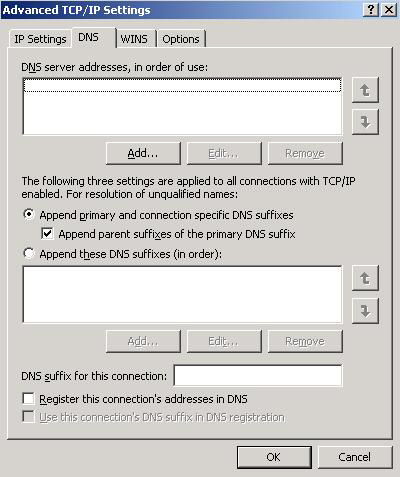
Figure 6: Configuring DNS settings for Private network
Click on the WINS tab, uncheck Enable LMHOSTS lookup and select Disable NetBIOS over TCP / IP .
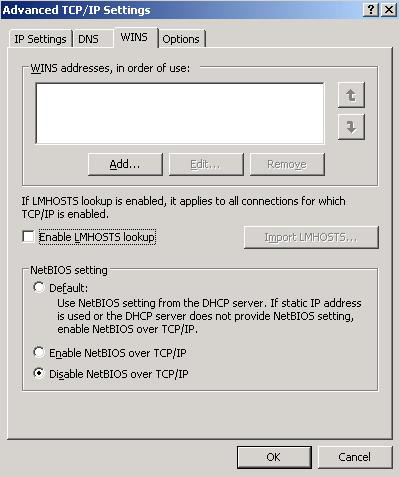
Figure 7: Configuring WINS settings for Private network
Click OK 3 times and close the network connection window.
Now add both Windows 2003 servers as a member server in the Active Directory domain test.
Create and configure Windows 2003 Server Cluster
We already have two servers ready to work as nodes in a Windows 2003 cluster, now create a Windows 2003 Server Cluster. To do so, log into E2K7Node1 with the domain administrator account, then click Start > Administrative Tools > Cluster Administrator , and select Create new cluster in the select list box. Click OK .
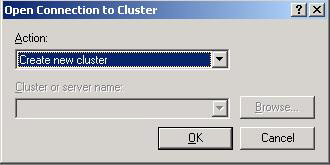
Figure 8: Create a new cluster
Note
You can also open a command prompt and type in the Cluster.exe / create / wizard command to open the Cluster Wizard utility.
Click Next .
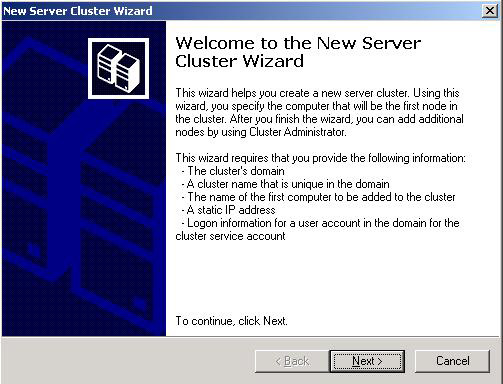
Figure 9: Cluster Wizard
Specify the domain name as well as the cluster name (the name for the Windows 2003 cluster, not the name of the Exchange cluster for the clients to connect to), and then click Next .
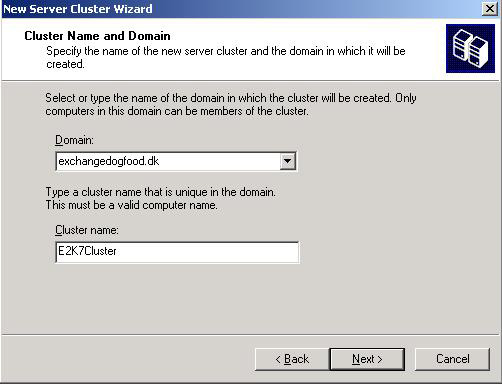
Figure 10: Cluster Name and Domain
Enter the name of the Windows 2003 server that will make the first node in the cluster, in this case E2K7Node1 , then click Next .
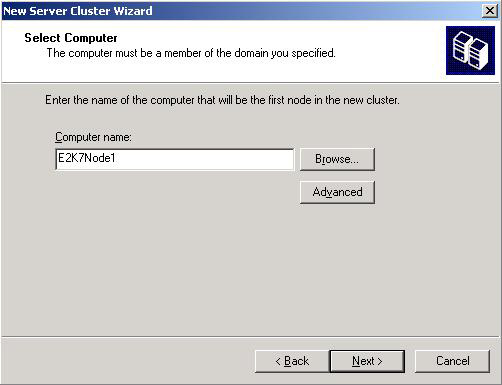
Figure 11: Add the first button
Allow the cluster wizard to determine the cluster configuration and click Next .
Note
You can ignore the two warnings in Figure 12, because the nodes in the cluster cluster (CCR) on the mailbox server installation will not share with small systems.
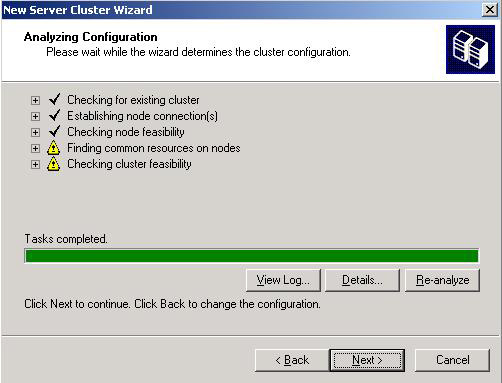
Figure 12: Analyzing Cluster Configuration - Analyzing Cluster Configuration
Enter the IP address that the cluster management tools will use to connect to the cluster, in this case 10.10.1.216, then click Next .
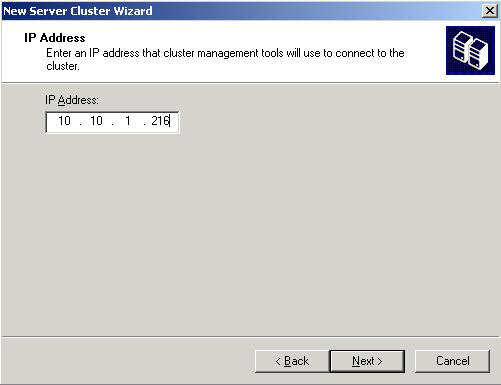
Figure 13: Specify the IP address that the cluster management tools will connect to
Enter the required information of the cluster service account (Cluster Service Account), click Next .
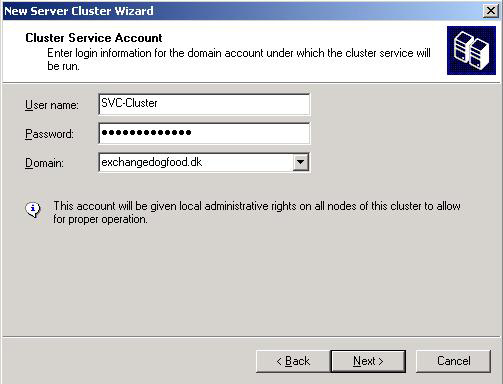
Figure 14: Enter the required information for the Cluster Service Account
Click Quorum and select Majority Node Set as a resource type, then click OK and Next .
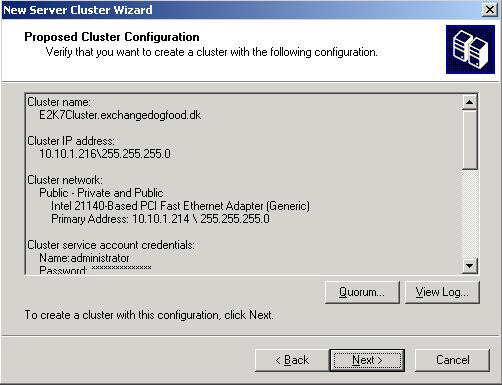
Figure 15: Cluster configuration given
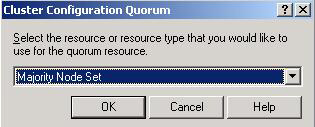
Figure 16: Setting Majority Node Set to Resource Type
Wait until the cluster is configured, then click Next .
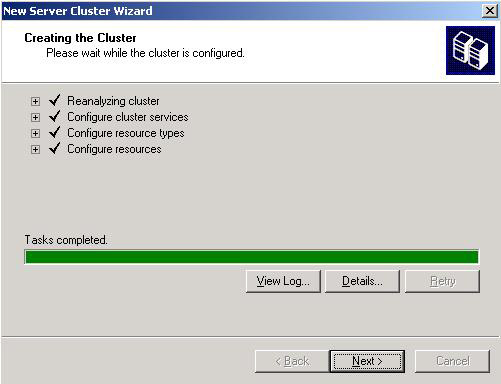
Figure 17: Creating Cluster
Once the cluster is complete, you can click Finish .
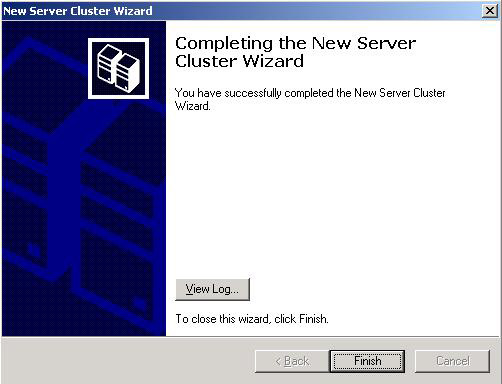
Figure 18: The alarm screen has completed the process
Now we are running the Windows 2003 cluster, but since there is only one node, it is not fault tolerant. So please add to the second Windows 2003 server. We can do this by right-clicking E2K7Node1 in the left pane of Cluster Administrator, then selecting New > Node as shown in Figure 19 below.
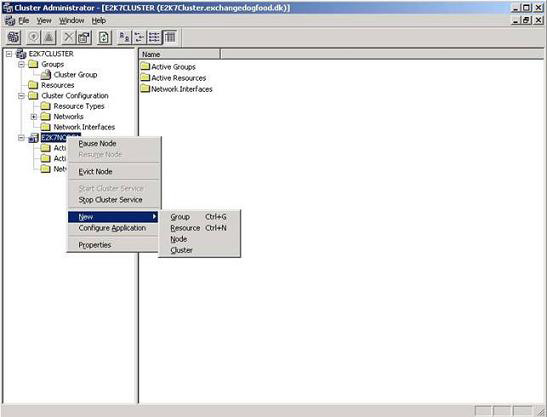
Figure 19: Adding the second node to the Cluster
The Add Nodes Wizard will launch and you can click Next .
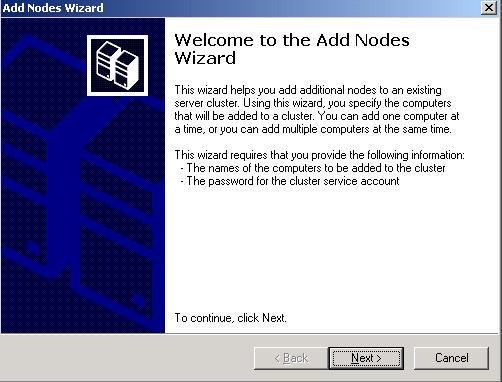
Figure 20: Add Nodes Wizard
Enter the name of the server that will be the second node (in this case E2K7Node2 ), then click Next .
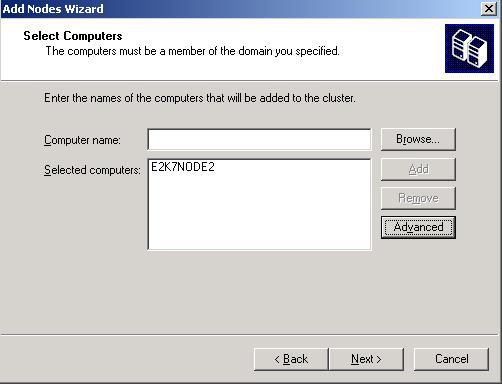
Figure 21: Enter the name of the second button
Continue for Add Notes Wizard to define the cluster configuration, then click Next .
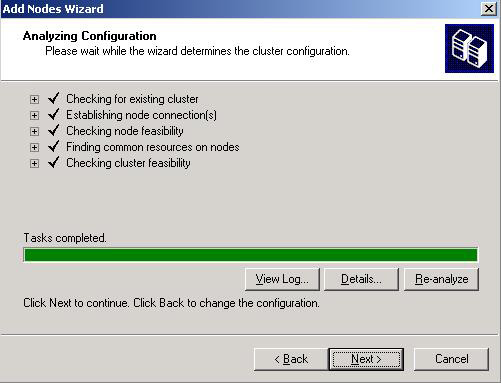
Figure 22: Analysis of Cluster configuration
Enter the password for the cluster service account (in this case, the administrator account), and then click Next .

Figure 23: Enter the password for the Cluster Service Account
Once authenticated, you want to add the second node to the cluster with the configuration shown in Figure 24, click Next .
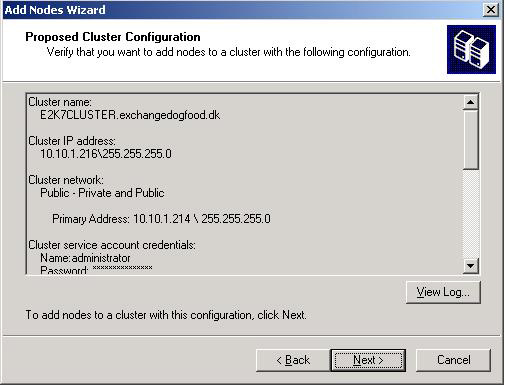
Figure 24: Recommended cluster configuration for node 2.
When the cluster is configured correctly without any errors or warnings appearing, click Next .
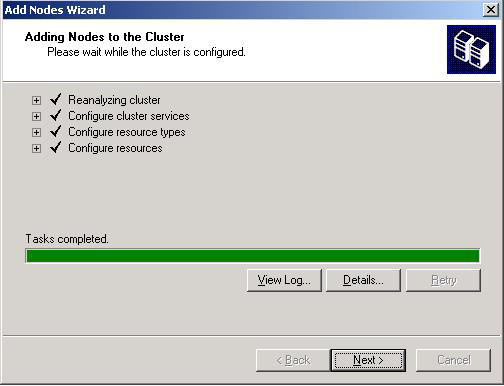
Figure 25: Cluster is configured for the second node
When the Add Notes Wizard has completed successfully, click Finish .
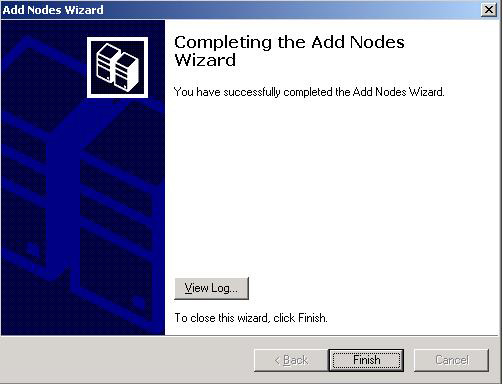
Figure 26: Complete the Add Nodes Wizard
The second Windows server is now part of the cluster as shown in Figure 27 below.
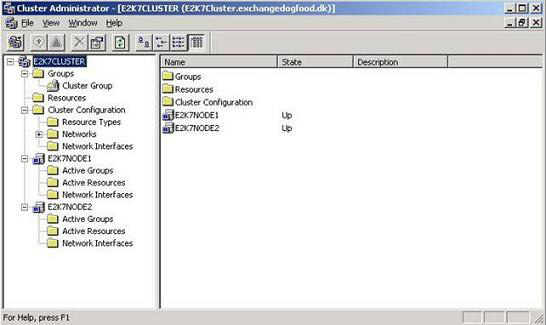
Figure 27: Cluster Administrator with two nodes
At this point, we would like to conclude the first part of this series, the second part will continue and we introduce it in a short time, please read.
 Installing, configuring, and testing Exchange 2007 CCR on Mailbox Server (Part 2)
Installing, configuring, and testing Exchange 2007 CCR on Mailbox Server (Part 2)
 Installing, configuring, and testing Exchange 2007 CCR on Mailbox Server (Part 3)
Installing, configuring, and testing Exchange 2007 CCR on Mailbox Server (Part 3)
You should read it
- Deploy CCR Cluster of Exchange 2007 SP1 on Windows Server 2008 Failover Cluster (Part 1)
- Installing, configuring, and testing Exchange 2007 CCR on Mailbox Server (Part 2)
- Failover Cluster Management configuration of Server 2008
- Exchange 2007 SP1: Manage CCR Cluster with the Exchange Management Console
- Installing, configuring, and testing Exchange 2007 CCR on Mailbox Server (Part 3)
- Load balancing in Web applications
- Backup for Exchange Server with DPM 2007 - Part 3: Backup process
- Forward from Exchange 2000/2003 to Exchange Server 2007 (part 2)
May be interested
- Learn about Mailbox Recovery Exchange 2010
 in some previous versions of exchange server, we can use the recovery storage group feature - rsg, allowing users to store copies of edb files of mailbox database, and can easily restore each of them. separate mailbox section or some other related elements such as mail, calendar or contact.
in some previous versions of exchange server, we can use the recovery storage group feature - rsg, allowing users to store copies of edb files of mailbox database, and can easily restore each of them. separate mailbox section or some other related elements such as mail, calendar or contact. - Transfer mailboxes in Exchange 2007 through Exchange Management Console (Part 2)
 in part 1 of this article, we introduced the move mailbox utility that is included in the exchange management console as well as other event logs recorded when the mailboxes were moved in exchange 2007. although the move mailbox utility provides one. the interface is simple to perform mailbox migration between databases and servers but it still lacks some
in part 1 of this article, we introduced the move mailbox utility that is included in the exchange management console as well as other event logs recorded when the mailboxes were moved in exchange 2007. although the move mailbox utility provides one. the interface is simple to perform mailbox migration between databases and servers but it still lacks some - Installing Exchange 2007 (Part I)
 installing exchange is an interesting job. exchange 2007 requires a number of distinct skills compared to many of its earlier versions. part i of this series gives you information about the requirements before c
installing exchange is an interesting job. exchange 2007 requires a number of distinct skills compared to many of its earlier versions. part i of this series gives you information about the requirements before c - Configuring Exchange Client Access with ISA 2006 (Part 1)
 configuring exchange server client access with isa will be an easy task without any hassles? actually this is not.
configuring exchange server client access with isa will be an easy task without any hassles? actually this is not. - Additions for Exchange Server 2007 - Part 1: Introduction steps
 in this series, i will show you how to add exchange server 2007 sp1 (beta), installed on windows server 2008 (also beta). we talked about the steps needed to add the underlying operating system by only installing a minimum number of server roles and services. in the second part, we plan to do it
in this series, i will show you how to add exchange server 2007 sp1 (beta), installed on windows server 2008 (also beta). we talked about the steps needed to add the underlying operating system by only installing a minimum number of server roles and services. in the second part, we plan to do it - Transfer mailboxes in Exchange 2007 through the Exchange Management Console
 there are many tasks that every exchange administrator must perform daily and moving mailboxes is one of those tasks. the most obvious example of mailbox migration is when a user is moved from one exchange server to another
there are many tasks that every exchange administrator must perform daily and moving mailboxes is one of those tasks. the most obvious example of mailbox migration is when a user is moved from one exchange server to another - Transfer from Linux Mail Server to Exchange Server 2007 (Part 1)
 in exchange server 2003, we can use the exchange migration wizard to switch from an imap4 running environment to active directory and exchange server 2003. in this article, however, i don't want to talk about exchange server 2003 but instead. gi
in exchange server 2003, we can use the exchange migration wizard to switch from an imap4 running environment to active directory and exchange server 2003. in this article, however, i don't want to talk about exchange server 2003 but instead. gi - Discover EMC in Exchange Server 2010 (Part 2)
 in the previous article, we learned some new features in exchange server 2010, including: high availability, archiving, federation and sharing.
in the previous article, we learned some new features in exchange server 2010, including: high availability, archiving, federation and sharing. - Installing Exchange 2007 (Part II)
 installing exchange is not difficult. however, exchange 2007 has some changes in the installation program that are a bit surprising. part 2 of this series will take you to the installation options of the gui and gui
installing exchange is not difficult. however, exchange 2007 has some changes in the installation program that are a bit surprising. part 2 of this series will take you to the installation options of the gui and gui - Execute Outlook Voice Access with Exchange Server 2007 (Part 1)
 a very popular new feature in exchange server 2007 enterprise edition is unified messaging (unified messaging). with this feature, you will have several options for remote connection to the mailbox. in this article, we will introduce you to c & a
a very popular new feature in exchange server 2007 enterprise edition is unified messaging (unified messaging). with this feature, you will have several options for remote connection to the mailbox. in this article, we will introduce you to c & a










 Installing, configuring, and testing Exchange 2007 CCR on Mailbox Server (Part 2)
Installing, configuring, and testing Exchange 2007 CCR on Mailbox Server (Part 2) GroupWise to Exchange 2007 - Part 2: Ability to collaborate and convert
GroupWise to Exchange 2007 - Part 2: Ability to collaborate and convert Mobile messaging in Exchange 2003 (Part 1): Introduction to Microsoft's DirectPush technology
Mobile messaging in Exchange 2003 (Part 1): Introduction to Microsoft's DirectPush technology Mobile messaging in Exchange 2003 (Part 2): Discover security policies
Mobile messaging in Exchange 2003 (Part 2): Discover security policies Mobile messaging in Exchange 2003 - Part 3: Installation, administration, and use of Microsoft Exchange Server ActiveSync Web Administration tool
Mobile messaging in Exchange 2003 - Part 3: Installation, administration, and use of Microsoft Exchange Server ActiveSync Web Administration tool